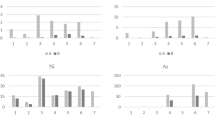Abstract
The quality of recycled magnesium from chips depends strongly on their exposure to inorganic and organic impurities that are added during the production processes. Different kinds of magnesium chips from these processes were analyzed by several methods. In addition, the accuracy and effectiveness of the methods are discussed. The results show that the chips belong either to the AZ91, AZ31, AM50/60, or AJ62 alloy. Some kinds of chips show deviations from the above-mentioned normations. Different impurities result mainly from transition metals and lime. The water and oil content does not exceed 25%, and the chip size is not more than 4 mm in the diameter. The sieve analysis shows good results for oily and wet chips. The determination of oil and water shows better results for the application of a Soxhlet compared with the addition of lime and vacuum distillation. The most accurate values for the determination of water and oil are obtained by drying at 110°C (for water) and washing with acetone (for oil) by hand.





Similar content being viewed by others
References
S. Ohmann, A. Ditze, and C. Scharf, World Metall. 67, 330 (2014).
A. Ditze and C. Scharf, Recycling of Magnesium, 1st ed. (Clausthal-Zellerfeld: Papierflieger Verlag, 2008), pp. 107–114.
T.W. Jelinek, Reinigen und Entfetten in der Metallindustrie, chap. 4 (Bad Saulgau: Leuze Verlag, 1999).
J. Schön, K. Buchmüller, N. Dahmen, P. Griesheimer, P. Schwab, and H. Wilde, EMSIC, ein pfiffiges Verfahren zur Entölung von Metall- und Glas-Schleifschlämmen, Forschungszentrum Karlsruhe, wissenschaftliche Berichte FZKA 6799, 2003.
G. Song and A. Atrens, Adv. Eng. Mat. 5, 837 (2003).
W.B. Jensen, J. Chem. Edu. 84, 1913 (2007).
R.N. Reeve, Environmental Analysis (New York: Wiley, 1994).
U.S. patent 5,338,335 (16 August 1994).
DE 10 2008 048 770 A1, Magnesium Solutions Europe, Verfahren zum Entfeuchten von metallischen Spänen, 2008.
EP 2 168 694 A1, Magnesium Solutions Europe, Verfahren zum Entfeuchten von metallischen Spänen, 2009.
DE 39 23 552 A1, Klöckner-Humboldt-Deutz, Verfahren zur Verarbeitung von in Walzwerken anfallendem Zunder, 1991.
P. Rosin and E. Rammler, J. Inst. Fuel 7, 29 (1933).
A. Ditze (Paper presented at the Entschwefelung von Roheisen und Stahl international symposium, Lisbon, 23–26 September 2008).
Author information
Authors and Affiliations
Corresponding author
Rights and permissions
About this article
Cite this article
Ohmann, S., Ditze, A. & Scharf, C. Analysis Methods of Magnesium Chips. JOM 67, 2747–2753 (2015). https://doi.org/10.1007/s11837-015-1630-2
Received:
Accepted:
Published:
Issue Date:
DOI: https://doi.org/10.1007/s11837-015-1630-2




